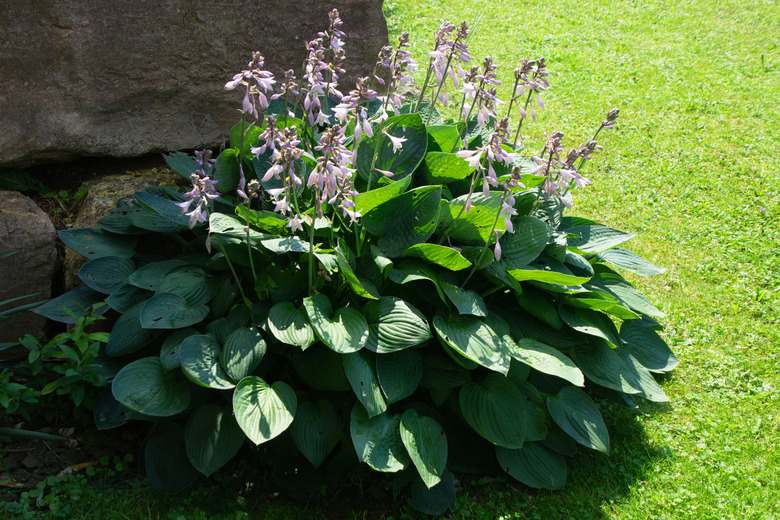What To Put On Hostas To Repel Bugs
We may receive a commission on purchases made from links.
The velvety leaves of the hosta (Hosta spp.) make gardeners fond of this plant, but these voluptuous leaves are just as attractive to pests — in particular, slugs and snails — that can single-handedly ruin a hosta in what seems like a nanosecond. Other pests find hosta an irresistible treat as well, so take action to repel these pests as soon as you notice damage.
Slugs and Snails
Slugs and Snails
If slugs or their shelled counterpart, snails, are attacking your hosta, you'll likely see the telltale, shiny trails either on the leaves or the ground around the plant. These slimy mollusks leave irregular, large holes in the leaves either at the edge or in the middle between the veins. If you notice one or two of these ragged holes, take action quickly because these pests have found a treat, and they'll be back for more.
Snails and slugs like moist environments, so they will be hiding out during the day in shady spots, such as under rocks, mulch, yard debris, or low foliage. The most common way that home gardeners deal with slugs and snails is to first clean up the area to limit these hiding spots. This might entail removing overly thick layers of mulch, pruning some plants to let in more light, and ensuring there are no boards, bricks, rocks, or other hiding places nearby. You can hand-pick them from their hiding places or pick them directly off the plants in the early morning or night and then dispose of them.
Usually, however, hand-picking and yard cleanup are not enough, although cleaning up your yard is the first critical component of any anti-snail strategy. The next step is to put out bait. Start with beer or any other fermented or yeast-containing liquid. Get a shallow pan, like a pie plate or plastic container, and bury it in the garden bed so that the lip of the pan is level with the soil. Fill it with your liquid. Slugs and snails will be attracted to the beer and will drown. Empty it and refill it regularly.
If stronger methods are required, use a pesticide formulated especially for mollusks called "molluscicide." Choose an organic product, such as Sluggo, which contains iron phosphate, or Sluggo Plus, which adds the bacterium spinosad, both of which are approved by the Organic Materials Research Institute.
Apply the bait as directed on the product label. Avoid piling it; rather, scatter it in moist areas where it's likely snails and slugs will travel. Bait is less effective when applied during very dry weather or extremely hot or cold weather.
Other Hosta Pests
Other Hosta Pests
Slugs and snails aren't the only pests that might be targeting your hosta. Cutworms, blister beetles, and grasshoppers might also go for your hosta's juicy leaves or stems. Cutworms are easy to identify because their favorite pastime is to sever a stem clear through; in the morning, your hosta leaf with stem will be lying on the ground. The best protection against cutworms is to surround the base of your hosta with a 3-inch-high paper or plastic collar. You can also hand-pick them off the plants at night. Generally, pesticides are not recommended for cutworm damage to ornamental plants.
Blister beetles and grasshoppers chew the hosta leaves in a similar fashion, so it's hard to identify the culprit, but control is basically the same. First, hand-pick them off, which should be effective in most home gardens. If that doesn't control them, there are really no chemical insecticides approved for grasshoppers in the home garden, so some methods gardeners recommend are garlic sprays or organic products formulated for biological control of these pests, such as Semaspore, which contains protozoan Nosema locusta. This method, however, kills nymphs and few adults, so it may not be useful for immediate control.
When hand-picking blister beetles, be careful and wear gloves. These beetles are called "blister" beetles because they can cause blisters on exposed skin. If you have a very heavy infestation (this is unlikely in a home garden), you can try a pesticide containing pyrethrum: Mix 1 tablespoon of alcohol per pint of diluted pyrethrum mixture in a spray bottle and spray your hosta every three to five days for two weeks. Be aware, however, that pyrethrum is toxic to not only beetles but important pollinators, including bees, so never apply it when the hostas are blooming or there are flowers close by.
Warning
To protect honeybees and other pollinators, never apply any pesticide, organic or chemical, when the targeted plant is flowering or there are flowers nearby.
Avoid getting any spray even on nearby flowering weeds, as these can attract bees as well. The safest time to apply pesticide is late afternoon or evening because most honeybees have returned to their hives by that time, providing them a window for the pesticide to decompose before they come out again in the morning.
